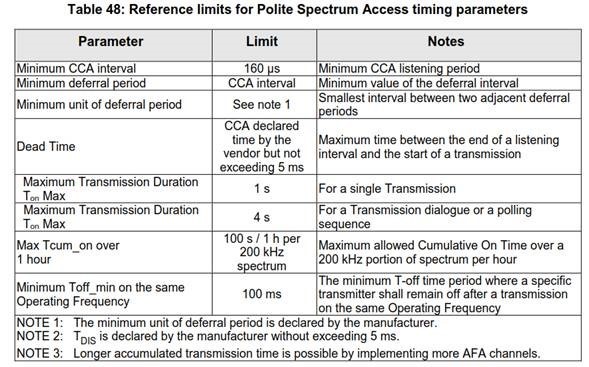Other Parts Discussed in Thread: CC1310
Hey guys,
we have just received information from our certification lab. We are planning to get CE based on EN 300 220 and "band L - channels" EN 300 440-2 as well as FCC based on 15.247 (FH).
We have a sensor collector setup in star topology, though there can be more than one collector present to handle all sensor nodes.
For collector we use CC1352R1 launchpad with external antenna with 4dB gain and the sensors are TIDA00489 boards. Note that the sensors are sleepy. For CE, we use non-beacon mode.
I do now have some basic questions, if the thread gets confusing, I will split it.
CE-certification:
1. Is there a function in SmartRF Studio, where I can use LBT.
In example, I use Packet Tx function to transmit to another device having the Packet Rx function running and I add a jamming device blocking on the employed frequency.
Can I use such a setup? If not I use sensor/collector example and add a jamming device.
2. In SmartRF Studio, there is the "Bit Error Rate". The lab is asking if there is some kind of "error correction" implemented in SmartRF Studio having an effect on the BER?
3. Since we want to use 865MHz - 868 MHz (L-band) according to EN 300 440-2 V3.1.1 annex B, there is another requirement regarding the max. output power besides the maximum 25 mW.
The power density limit is 6.2dBm/100kHz. Are we within this spec with our devices using sensor/collector example with PHY_ID: APIMAC_GENERIC_ETSI_LRM_863_PHY_131?
4. The lab wants us to provide the following information regarding LBT according to EN 300 2220-1 V3.1.1 table 48.

Some information from our side:
- the maximum packet length is our data packet with approx. 330 bytes (@5kbps)
- We do not have other messages than data, polling (content of config message is out of box) or association/disassociation
- we have CONFIG_MAX_DATA_FAILURES 2 and CONFIG_MAX_RETRIES 3
- CONFIG_MIN_BE 3 | CONFIG_MAX_BE 5 | CONFIG_MAC_MAX_CSMA_BACKOFFS 4
4.1 Is it possible to set the duration between two retries? I think it has to be higher than 100 ms?
4.2 Could you provide the infos (or give me a link). I assume, Tmax for single transmission or dialogue or the Max Tcum has to be handled by the application and there is no feature in the MAC layer handling it automatically?
FCC Certification:
1. Regarding the active hopping test, is it possible to enable hopping in SmartRF Studio somewhere? But I think there is the certification test mode in the sensor/coll example for this test, right?
2. I think the certification test mode is usefull to test the hopping of the collector, but since our sensors are sleepy, is it enough for the test that the sensor follow the collector or is there a test,
where the sensors are hopping actively to "demonstrate" this ability and the collector is sending messages to it?
Best wishes
Slev1n

